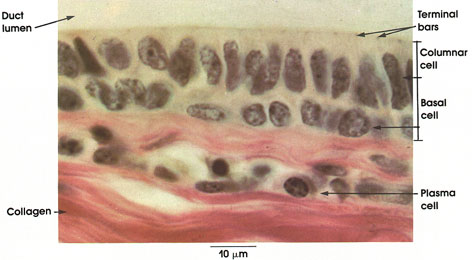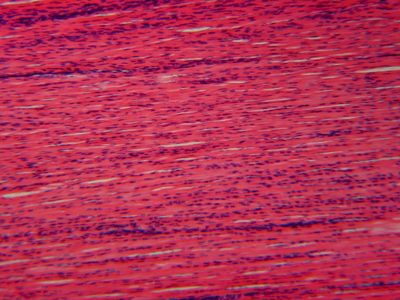Cards In This Set
| Front | Back |
|
Simple Squamous Epithelium[Think squamous=scaley]
|
Functions: Reduces friction, controls permeability, performs absorption and secretion. |
|
Stratified Squamous Epithelium[think stratified=stratos, or 'layers']
|
 Functions: Provides physical protection against abrasion, pathogens and chemical attack. |
|
Simple Cuboidal Epithelium[think cube=square shaped]
|
 Functions: Limited protection, secretion, absorption. |
|
Stratified Cuboidal Epithelium[think stratos=layers and cube=square shaped]
|
 Functions: Protection, secretion, absorption. |
|
Transitional Epithelium[think transition=adjusting, such as to accomodate movement]
|
 Functions: Permits expansion and recoil after stretching. |
|
Simple Columnar Epithelium[think columnar=columns]
|
 Functions: Protection, secretion, absorption. |
|
Psuedostratified Ciliated Columnar Epithelium[think psuedo stratos=false layer, ciliated=containing cilia, columnar=columns]
|
 Functions: Protection, secretion, moving mucus with cilia. |
|
Stratified Columnar Epithelium[think stratos=layer and columnar=columns; no cilia on this one]
|
 Function: Protection |
|
Adipose Tissue[think adip=adapt, helps to cushion and allow things to 'adapt' to outside influences]
|
 Functions: Provides padding and cushions shocks, insulates [reduces heat loss], stores energy. |
|
Reticular Tissue[think retic=retain, as in retain shape]
|
Functions: Provides supporting framework [found in soft organs]. |
|
Dense Regular Connective Tissue[think dense=strong/firm, regular=one way/typical in direction]
|
 Functions: Provides firm attachment. conducts pull of muscles, reduces friction between muscles, stabilizes relative positions of bones. |
|
Dense Irregular Connective Tissue[think dense=strong/firm and irregular=different ways/atypical in direction]
|
 Functions: Provides strength to resist forces pulled in many directions, helps prevent overexpansion of organs such as urinary bladder. |
|
Elastic Tissue[think elastic=stretchy]
|
Functions: Stabilizes positions of vertebrae and penis, cushions shocks, permits expansion and contraction of organs. |
|
Hyaline Cartilage[think hyaline=to line, often between bones]
|
 Functions: Provides stiff but somewhat flexible support, reduces friction between bony surfaces. |
|
Elastic Cartilage[think elastic=stretchy, willing to move]
|
 Functions: Provides support but tolerates distortion without damage and returns to original shape. |



